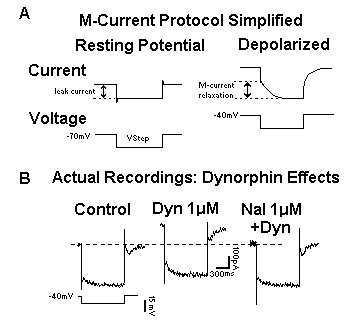
| Figure 4. |
 |
| Schematic of a simple voltage-clamp protocol for recording the M-current, and representative M-current records showing opioid effects. A: The M-current was one of the first voltage-dependent conductances shown to be altered by neurotransmitters. The left panels show the expected current response to a small (5–10 mV) hyperpolarizing voltage command if there were no open M-channels in the membrane (for example, at holding potentials of -65 or more hyperpolarized). Here, only an abrupt, non-voltage-dependent "ohmic" drop (due to the so-called leak current) is evoked, giving rise to a rectangularly shaped current response. However, if the membrane is depolarized by clamping it at around -50 mV or more depolarized, and the same-sized voltage command is delivered (right panel), the abrupt ohmic drop is followed by an inward current relaxation that is actually due to the slow (time- and voltage-dependent) closing of many M-channels that were persistently open at the more depolarized potential (i.e., a reduction of an outward K+ current). A measure of the M conductance at the holding potential can be obtained by measuring the current difference between the end of the ohmic drop and the "steady-state" current toward the end of the hyperpolarizing command. Duration of voltage command: about 1 sec. B: Typical M-current recordings from a CA1 hippocampal pyramidal neuron using a single-electrode voltage clamp and a holding potential of -40 mV. Note the dynorphin-evoked increase in the size of the M-current, as manifested by the increased slope of the inward relaxation during the 15-mV hyperpolarizing voltage command (protocol at lower left) and the overall size of the current response (a conductance increase). The large outward shift in the baseline (holding) current is also consistent with an increase in the M-current evoked by dynorphin at depolarized membrane potentials. All these effects of dynorphin are reversed by naloxone (right panel), indicating involvement of an opiate receptor. Dotted line: Original control holding current. (from ref. 34). |
published 2000